Dust Particles Entering the Room, Ansys Fluent Training
$80.00 Student Discount
- The problem numerically simulates the Dust Particles Entering the Room using ANSYS Fluent software.
- We design the 3-D model by the Design Modeler software.
- We Mesh the model by ANSYS Meshing software, and the element number equals 42061.
- We use the Discrete Phase Model (DPM) to study the sedimentation of dust particles.
To Order Your Project or benefit from a CFD consultation, contact our experts via email ([email protected]), online support tab, or WhatsApp at +44 7443 197273.
There are some Free Products to check our service quality.
If you want the training video in another language instead of English, ask it via [email protected] after you buy the product.
Description
Description
The present study investigates the dust particles entering from the windows into a room by ANSYS Fluent software. We perform this CFD project and investigate it by CFD analysis.
The present model is designed in three dimensions using Design Modeler software. The geometry for analyzing this simulation consists of a room in which 2 windows and a chimney exist.
The meshing of the model has been done using ANSYS Meshing software. The element number is 42061. Also, due to the nature of the problem, the transient solver has been enabled.
Dust Particles Methodology
In this project, the dust particles entering the building at a velocity of 0.25 m/s are examined, and the house’s sedimentation and dust movement are depicted. To simulate the sedimentation process discrete phase model is used.
Also, a two-way DPM model is used to examine the behavior of particles moving inside the room accurately.
The airflow enters the domain through inlet boundaries (i.e., the two windows) and brings particles inside the room; then, it leaves the room through the pressure outlet boundary considered on the top side of the chimney. Moreover, the laminar model is used to solve the fluid equations.
Dust Particles Conclusion
At the end of the solution process, two-dimensional contours related to the velocity, velocity vectors, and streamlines inside the room are obtained. We can see from the contours, the airflow, and the movement of the dust.
The flow created by the wind speed carries the dust in the direction of the flow. As a result, dust in areas of vortex formation may have more sediment.
[/vc_column_text]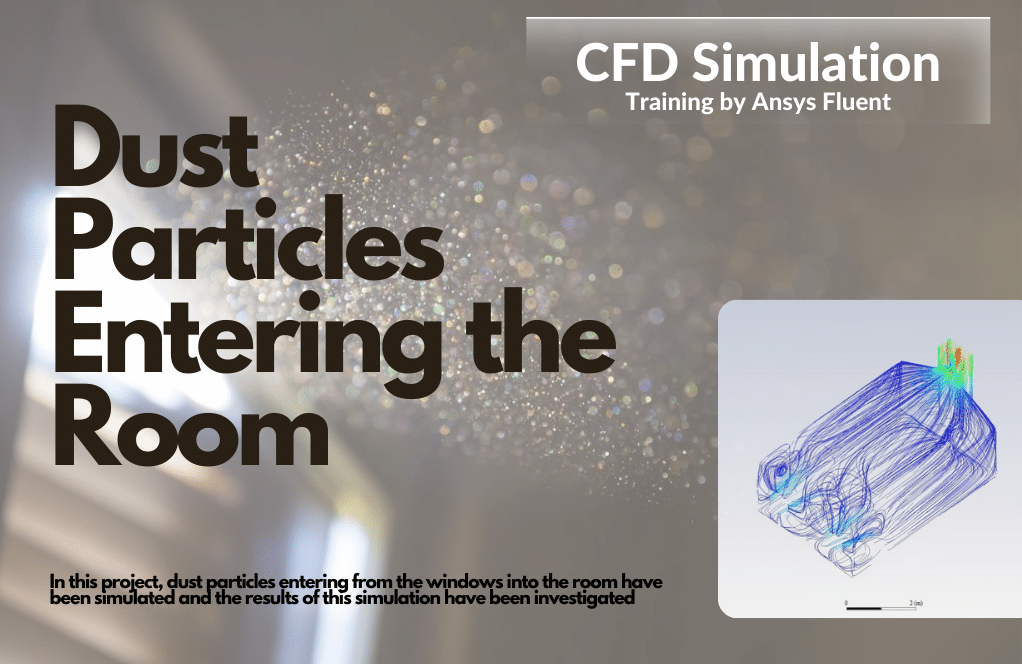




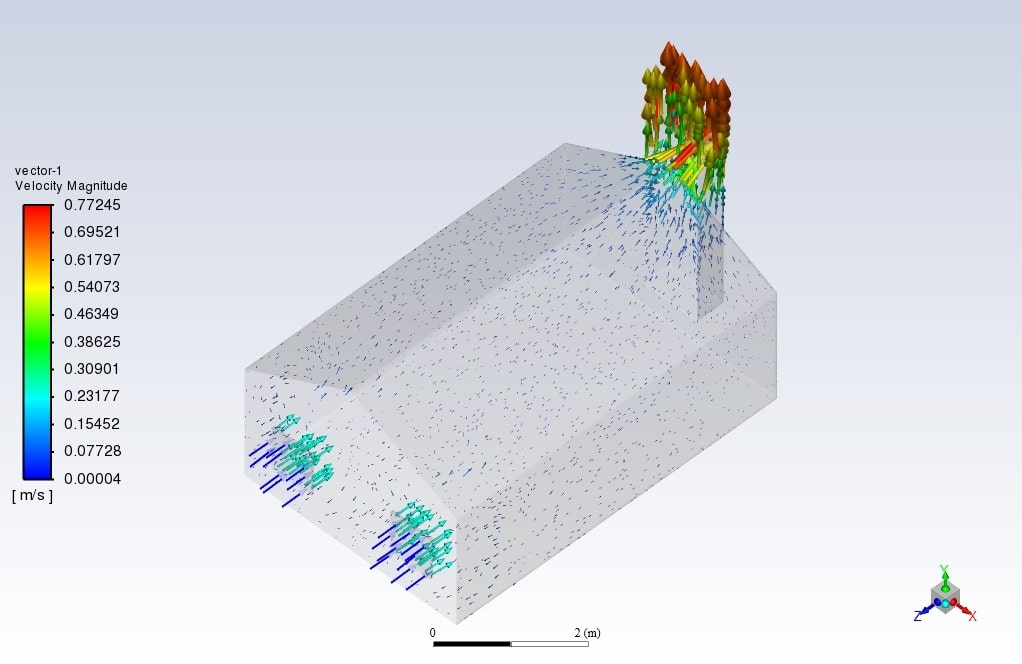
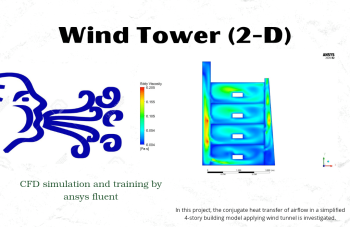
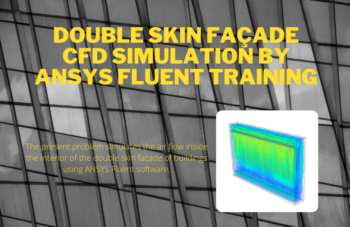
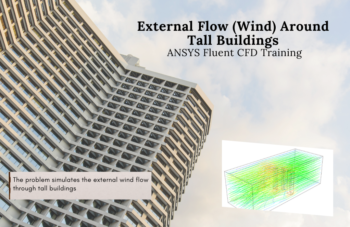
Tania Littel –
Can you tell which factors or settings in the simulation setup help in identifying the accumulation areas of dust better?
MR CFD Support –
The identification of accumulation areas in a particle-driven flow, like the one investigated for dust entering a room, is improved with the use of the discrete phase model (DPM). Detailed tracking of dust particle trajectories coupled with accounting for the effects of turbulence, boundary interaction, and gravity will allow for better prediction. The choice of transient analysis and simulation of realistic inlet velocities also contributes to the accurate prediction of dust accumulation.
Eloy Fisher –
This training was excellent—it showed the practical application of CFD in indoor air quality studies. Can any air purifier within the simulation space mitigate the spread and sedimentation of the dust?
MR CFD Support –
We appreciate your positive feedback. Regarding air purifiers, their effect was not included in the mentioned study since it focused on particle entry and sedimentation without mitigation measures. However, incorporating an air purifier in the simulation could be an interesting follow-up study to observe how it alters dust dynamics.
Mr. Ulises Strosin MD –
Are different sizes and weights of dust particles taken into account in the simulation, and how does it affect their movement and the final results? Can this simulation help design better ventilation systems?
MR CFD Support –
The simulation indeed considers different sizes and weights of dust particles, as the DPM (Discrete Phase Model) allows for tracking of a wide range of particle properties. The particles’ movement and sedimentation are influenced by these properties, affecting the final results, including where dust is likely to accumulate. Yes, such a simulation can help in designing better ventilation systems by understanding airflow patterns and dust movement, allowing engineers to optimize airflow to minimize dust accumulation and improve air quality.
Shawn Lind –
The training material was great! The visuals helped a lot in understanding how dust particle movement and sediment occur in a room with windows and a chimney.
MR CFD Support –
Thank you for your positive feedback! We’re delighted to hear that the visuals were effective in enhancing your understanding of the dust particle dynamics. If you have any further questions or need additional resources to enrich your learning experience, please reach out.
Mohammad Hoeger –
The details on dust particle simulation are incredibly intricate! The study of particles and airflow through the room makes for a practical and fascinating analysis.
MR CFD Support –
Thank you for your positive feedback! We are delighted to hear that you find the simulation of dust particles and airflow through a room both practical and intriguing. It is our goal to provide comprehensive and detailed studies. If you have any further questions or need more information, please feel free to reach out. Thank you for choosing our CFD products for your learning and research needs.
Zackary Lesch –
The inclusion of the chimney seems like it would affect the flow pattern within the room. How was the impact of the chimney’s influence handled in this simulation, and how did it affect the overall dust distribution?
MR CFD Support –
In this simulation, the chimney provides an outlet for the air and particles to leave the room. It significantly influences the flow pattern, creating an upward stream as the air leaves. This was taken into account by defining a pressure outlet boundary condition at the chimney top. The rising warm air from the chimney can create an upward draft that impacts the particle trajectories, potentially altering their sedimentation behavior. This effect is captured through the transient solver and two-way DPM, which enables the assessment of dust distribution changes as affected by the chimney’s influence.
Irma Stanton –
I was impressed by the coverage in the simulation, but are we able to visualize the individual dust particles’ pathways as they settle inside the room?
MR CFD Support –
In this simulation, particle tracking visualization is used to illustrate the movement of individual dust particles, showing their pathways and settlement patterns within the confines of the room.
Dr. Trenton Price –
Is the discrete phase model in this simulation also accounting for particle-particle interaction or just the interaction of particles with the air flow?
MR CFD Support –
The discrete phase model (DPM) in this simulation mainly focuses on tracking the interaction of particles with the airflow, considering the influence of the airflow on the trajectory of the dust particles. If particle interaction is a relevant factor in your research, additional settings such as the DPM collision model can be enabled to account for particle-particle interaction.
Philip Langworth –
Is the entire room modelled and simulated, or are there specific sections that are omitted to reduce computational cost?
MR CFD Support –
In this CFD project, the entire room with the dust entry from windows and chimney exhaust is modelled and simulated to capture the dust particles’ behavior and sedimentation accurately in the room’s environment.
Destinee Mraz –
Could you explain if other turbulence models besides laminar can be used in studies like this to simulate airflow and dust particle behavior?
MR CFD Support –
In simulations involving dust particles and airflow within a room, turbulence models other than the laminar flow model, such as the k-ε or k-ω models, could be used if the flow becomes turbulent due to high velocities or complex interactions. These models allow for a more accurate representation of the chaotic and eddy motions associated with turbulent flows, which might be significant in certain circumstances of particle transportation and distribution.
Mitchell Bradtke –
The training for simulating dust particles was outstanding! I learned a lot about DPM model setup and particle behavior in an indoor environment.
MR CFD Support –
Thank you for your kind words! We are delighted to hear that our Ansys Fluent training for simulating dust particles was helpful for you. It’s great to know that our efforts in explaining the DPM model setup and indoor particle behavior are appreciated. If you ever have any more questions or need further assistance, feel free to reach out!
Reanna Gislason II –
I am absolutely thrilled by the detailed analysis of dust movement provided by the ANSYS Fluent training! The study’s findings on dust behavior and airflow interaction are fascinating and incredibly informative.
MR CFD Support –
Thank you for your kind words! We’re thrilled to hear that you found the training on dust particle analysis in a room using ANSYS Fluent insightful. Your enthusiasm for the study gives us great motivation to continue providing in-depth training and high-quality analyses. If there’s anything more you’d like to learn about or any further assistance you need, please let us know!